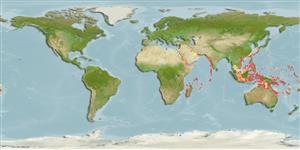Hexacorallia |
Scleractinia |
Merulinidae
Environment: milieu / climate zone / गहराई सीमा / distribution range
पारिस्थितिकी
प्रवाल-भित्ति संयुक्त; गहराई सीमा 0 - 40 m (संदर्भ 848). Tropical; 36°N - 34°S, 26°E - 137°W (संदर्भ 848)
Indo-Pacific.
Length at first maturity / आकार / Weight / Age
परिपक्व अवधि: Lm ? range ? - ? cm
Colony: hemispherical or flat. Corallites: angular, deep. Septa: prominent, large conspicuous teeth present. Weakly developed paliform lobes. Wide range of colors, often with contrasting walls and oral discs (Ref. 848). Corallites are large, with fleshy, purplish coenosarc. Polyps with greyish oral disc and tentacles. Skeleton have adjoining, slight angular thecal walls (Ref. 130769).
Known from a wide range of reef environments and rocky foreshores (Ref. 848). Live specimens are easily distinguished. Usually found in the mid range of coral communities (Ref. 130769).
Life cycle and mating behavior
परिपक्व अवधि | पुनरुत्पत्ति | मछलीऔ का अंडे देना | Eggs | Fecundity | Larvae
Hermaphroditic (Ref. 113712). Mature gametes are shed into the coelenteron and spawned through the mouth. Life cycle: The zygote develops into a planktonic planula larva. Metamorphosis begins with early morphogenesis of tentacles, septa and pharynx before larval settlement on the aboral end (Ref. 833).
Nemenzo, F. Sr. 1986 Guide to Philippine Flora and Fauna. Corals. Natural Resources Management Center, Ministry of Natural Resources and University of the Philippines. 5:273 pp. (संदर्भ 910)
IUCN Red List Status
(संदर्भ 130435: Version 2025-1)
CITES status (संदर्भ 108899)
CMS (संदर्भ 116361)
Not Evaluated
Threat to humans
Human uses
| FishSource |
साधन
अधिक जानकारी
Trophic EcologyFood items (preys)
संघटक आहार
आहार खपत
परभक्षी
Population dynamicsबाढ़
Max. ages / sizes
Length-weight rel.
Length-length rel.
Length-frequencies
Mass conversion
बहुतायत
PhysiologyOxygen consumption
Human RelatedStamps, coins, misc.
इंटरनेट स्रोत
Estimates based on models
Preferred temperature
(Ref.
115969): 24.7 - 28.9, mean 27.6 (based on 368 cells).
Price category
Unknown.
